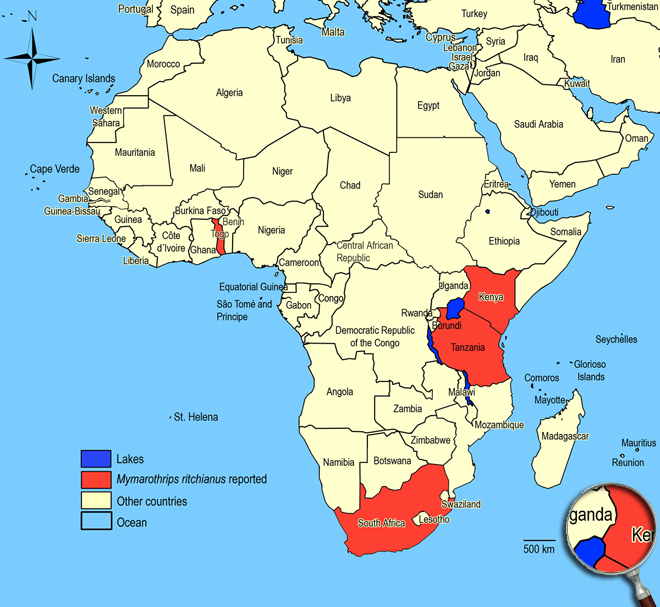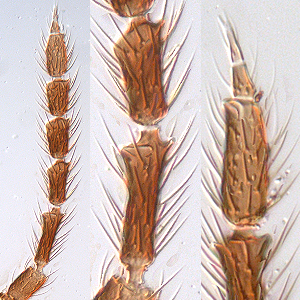Mymarothrips ritchianus Bagnall, 1928
Aeolothripidae, Terebrantia, Thysanoptera
Figures
Fig. 1: 9-segmented antenna, segment III and IV, terminal segments VII-IX
Fig. 2: Head dorsal with ocellar triangle
Fig. 3: Head ventral, mouth cone with mandibula and maxillary stylets
Fig. 4: Pronotum
Fig. 5: Meso- and metanotum
Fig. 6: Fore wing, basal region of fore wing
Fig. 7: Apical region of fore- and hind wing
Fig. 8: Abdominal segments 9-11 (lateral, female)
Introduction and recognition
Mymarothrips ritchianus is presumed to be predator on the larvae of thrips particularly certain Panchaetothripinae. Female macropterous; body bicolored, mainly yellow with pronotum and head laterally brown, abdominal segment 9 distally and 10 wholly brown; antennae dark brown, segment I & II and VII-IX not quite so dark as the intermediate segments; fore wings pale with large transverse dark area. Antennae 9-segmented; segments II-VII sub-equal in length, short and rectangular with many long setae; VIII & IX small and shorter than VII; linear sensoria on segments III & IV transverse ventrally at apex (Fig. 1). Head with 2 pairs of dominant postocular setae (Fig. 2); eyes slightly prolonged ventrally (Fig. 3); maxillary palps with distal segment subdivided into small units. Pronotum with several pairs of long pointed setae (Fig. 4). Mesonotum with median pair of setae long and arising on anterior half of sclerite. Metanotum with no sculpture medially (Fig. 5); both pairs of setae at anterior margin. Tarsi 2-segmented, fore tarsi with strongly recurved hamus that meets apex of a small seta. Fore wing characteristicly raquet-shaped, more than twice as wide distally as basally, apex broadly rounded; longitudinal veins strongly diverging, each bearing a row of long setae (Fig. 6 and 7). Tergite VIII with median setae extending well beyond posterior margin of tergite; tergite X without trichobothria. Sternites IV-VI with 4 pairs of marginal setae, usually without discal setae.
Male smaller than female; not bicolored, brown with red internal pigment; antennal segments III-VII with sensorium extending laterally along sides of each segment; tergite I wider than long; median tergites with discal setae about half the length of a tergite; sternites with discal setae, VIII & IX each with about 10 discal setae.
Taxonomic identity
Species
Mymarothrips ritchianus Bagnall, 1928
Taxonomic history
-
Common name
-
Present taxonomic position
Family: Aeolothripidae Uzel, 1895
Genus: Mymarothrips Bagnall, 1928
Genus description
The genus Mymarothrips Bagnall, 1928
5 species have been described in the Old World genus Mymarothrips, of which 2 of are now placed into synonymy. However, even the remaining 3 may be no more than color variants of a single widespread species (Mound & Marullo 1998). These 3 species, Mymarothrips ritchianus from Africa, Mymarothrips garuda from India and southern China, and Mymarothrips bicolor from Indonesia and northern Australia, exhibit slight differences from each other in the extent of shading on the fore wings. The genus is highly distinctive, with the racquet-shaped form of the fore wings (greatly expanded subapically) and the moniliform antennal segments quite unlike the wings or antennae of any other Aeolothripidae.
Species description
Typical key character states of Mymarothrips ritchianus
Coloration and body sculpture
Body color: distinctively bicolored or mainly pale to yellow, or with some darker markings
Antennae
Number of antennal segments: 9
Form of sensorium on antennal segment III and IV: transverse at apex
Length of antennal segment III: about 3 to 4 times as long as wide
Length of antennal segment V: much shorter than VI to IX together
Wings
Fore- and hind wings: present, more than half as long as abdomen
Fore- and hind wing surface: covered with microtrichia
Fore wing surface: not reticulate
Fore wing shape: apical third more than twice as wide as basal third (racquet- or spoon-shaped form)
Fringe cilia arising: from sockets
Fore wing veins: present
Number of cross veins: 2-3 (4)
Fringe cilia on posterior margin near apex: straight
Shape of fore wing apex: with continuous rounded margin
Fore wings: alternating bands of dark and light
Fore wing extreme apex color: pale
Abdomen
Ovipositor curved: upwards
Sternites IV, V and VI: with marginal setae and without or with a few discal setae laterally
Median posterior marginal setae on sternite VII: without supernumerary setae arising in front of marginal setae
Abdominal segment 10: never tubular, longitudinally incomplete ventrally in both sexes

Similar or related species
Compared to other members of Aeolothripidae Mymarothrips ritchianus has a racquet-shaped form of the fore wings (greatly expanded subapically) and moniliform antennal segments. Apparently related to the genus Allelothrips in the sub-basal constriction and the granular-like markings (reduced microtrichia) of the fore wings and also the well developed costal setae (Mound 1968).
Biology
Life history
As with other thrips species the life cycle from egg to adult is dependent on temperature. The full cycle can take about 15 days (Lewis 1973) to over a month and adults may live for more than one month producing several generations in one year depending on seasonal weather.
Host plants
Adults and larvae are presumed to be predators on the larvae of certain Panchaetothripinae living on the leaves of indigenous trees like lavender tree (Heteropyxis natalensis) and water berry (Syzygium cordatum) or important crops as coffee and yam.
Vector capacity
None identified
Damage and symptoms
-
Detection and control strategies
-
Additional notes
-
Biogeography
Tropical Africa. Kenya, Tanzania (Rubunge), Togo (Sotoubous),
South Africa (Gauteng).
African countries where Mymarothrips ritchianus has been reported

The species Mymarothrips ritchianus was not observed in surveys undertaken in East Africa on vegetables and associated weeds and crops.
Please click here for survey sites of all observed thrips species of Kenya, Tanzania and Uganda.

Bibliography
Bagnall RS (1928). Preliminary description of Mymarothrips ritchianus, a new type of Thysanopteron. Annals and Magazine of Natural History, Zoology, Botany and Geology. (Serie 10) 1: 304-307
Lewis T (1973). Thrips: Their biology, ecology and economic importance. Academic Press Inc., London Ltd., 349 pp
Moritz G (2006). Thripse. Pflanzensaftsaugende Insekten, Bd. 1, (1. Auflage). Westarp Wissenschaften, Hohenwarsleben, 384 pp. ISBN 13: 978 3 89432 8917
Moritz G, Morris DC & Mound LA (2001). ThripsID - Pest thrips of the world. ACIAR and CSIRO Publishing Collingwood, Victoria, Australia, CDROM ISBN 1 86320 296 X
Mound LA (1968). A review of R. S. Bagnalľs Thysanoptera collections. Bulletin of the British Museum (Natural History), Entomology. Supplement 11: 1-181
Mound LA & Marullo R (1998). Biology and identification of Aeolothripidae (Thysanoptera) in Australia. Invertebrate Taxonomy. 12 (6): 929-950
Palmer JM (1990). Identification of the common thrips of Tropical Africa (Thysanoptera, Insecta). Tropical Pest Management. 36 (1): 27-49
zur Strassen R (1960). Catalogue of the known species of South African Thysanoptera. Journal of the Entomological Society of Southern Africa. 23 (2): 321-367
zur Strassen R (1980). Thysanopterologische Notizen (5) (Insecta: Thysanoptera). Senckenbergiana Biologica. 60 (3-4) : 191-202
----
Web links
Mound´s Thysanoptera pages
Thysanoptera Checklist
ICIPE Thrips survey sites
UNI Halle & Thrips sites
Thrips of California











